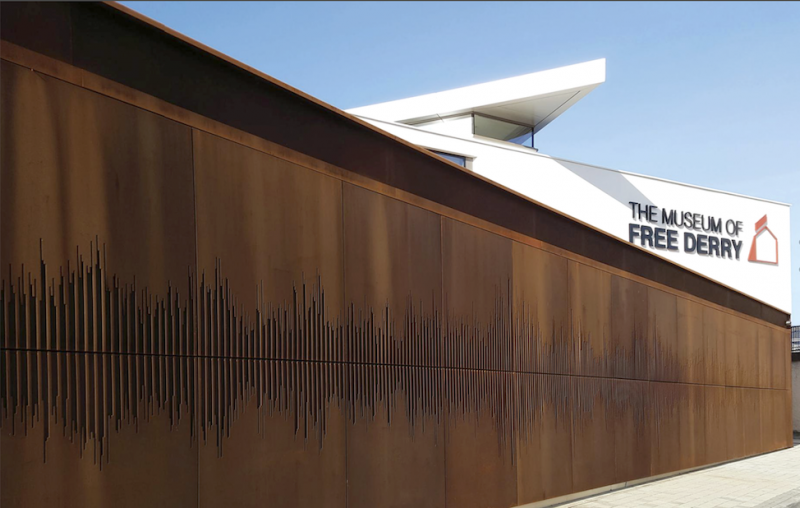
We Shall Overcome (2017) Weathering Steel. Integrated architectural artwork. Museum of Free Derry. Glenfada Park, Derry
'The artwork on the front of this museum shows the sound waveform of the moments on the day of Bloody Sunday in Derry in 1972, when the crowd sings 'We Shall Overcome’, a song that had become an anthem for the Civil Rights movement from the late 1950s and early 60s onwards.
An emphasis is placed on the surface of the museum having been cut into, along with the suggestion of a huge moment of seismographic shift. It draws also on a number of other ideas, among which are the lines of the wooden fence that would have run along this part of Glenfada Park and in a certain sense draws another line with the infamous ‘rubble barricade’ that would have crossed Rossville Street on that fateful day. Although it has its focus around this momentous event, it is hoped that it will resonate outside this context and connect, historically and contemporaneously, with a wider international communal struggle and desire for Justice and Civil Rights'
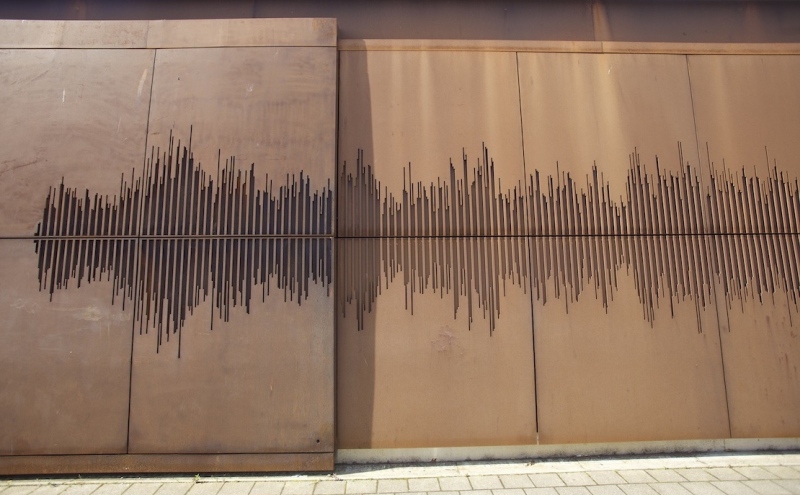
We Shall Overcome (2017) (detail) Weathering Steel. Integrated architectural artwork. Museum of Free Derry, Glenfada Park, Derry
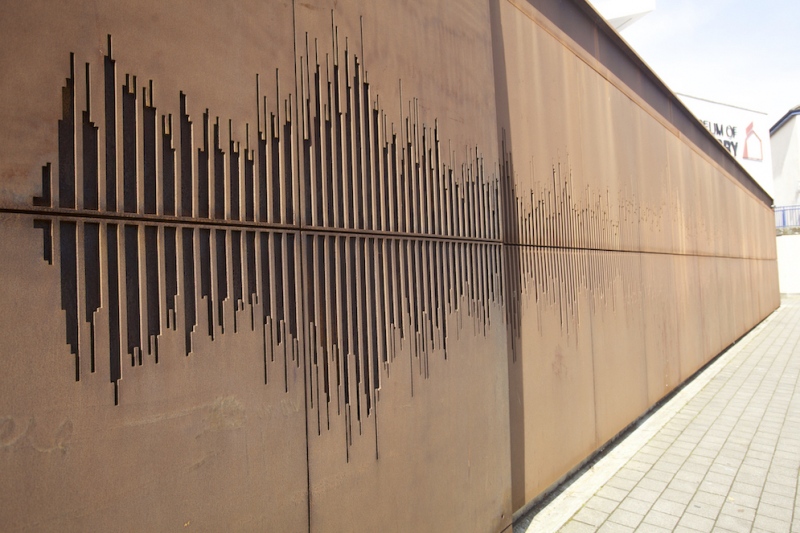
We Shall Overcome (2017) (detail) Weathering Steel. Integrated architectural artwork. Museum of Free Derry, Glenfada Park, Derry
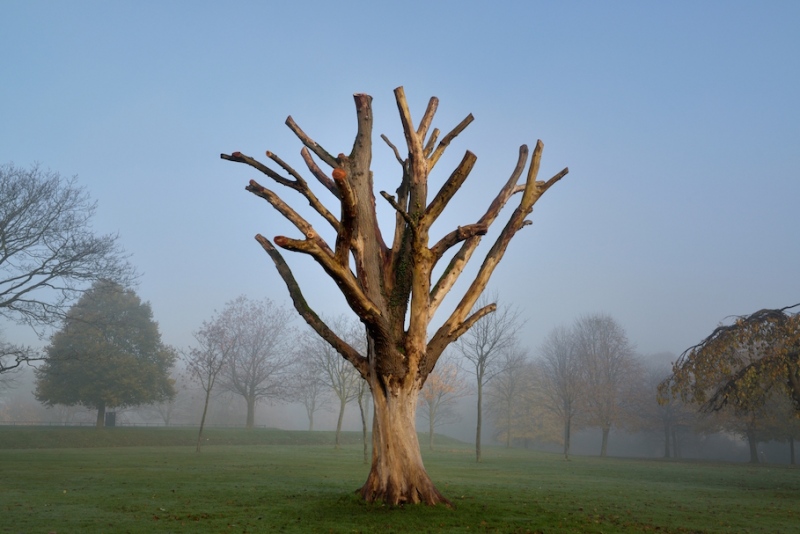
Dead On (2013/14) Dead Elm tree, audio, hardware. Brooke Park, Derry. Void Gallery Sites Gardens' Project
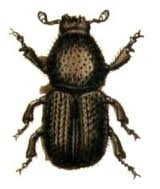
'The tree, an elm, was killed by Dutch Elm Disease, caused by the fungus Ophiostoma novo-ulmi. It is a type of disease known as a vascular wilt because the fungus blocks the vascular (water transport) system, causing the branches to wilt and die. It is spread by elm bark beetles Scolytus multistriatus. The beetles burrow their way into the dying or dead tree, the female laying eggs and adults, carrying the Dutch Elm pathogen emerge into the world to find new victims nearby.
Drilling and boring has been at the essence of Morris’s approach to Dead On mimicking the bark beetle’s invasion on the conscious and subconscious level. Many of us have a terror of drilling, often caused by the fear of the dentist’s drill, so much so that we’d rather endure the pain of toothache than go to the dentist. There’s even a term for it: Odontophobia - a state of denial, a terror of invasion even that of a supposedly benign nature. So if we’re afraid of what’s good for us imagine how terrifying the indifference of nature is; how the insectoid, the fungal, the viral care nothing for our civilization or superiority. As we listen to the tree, something is alive in there. The sounds are familiar yet unsettling; something seems to be eating its way out…
Locky Morris was born in Derry, where he continues to live and work. He has been exhibiting nationally and internationally since the mid - 1980s while also exhibiting in a wide range of spaces in his local neighbourhood. His practice has also included many works and interventions in he public realm.
Dead On is the third of the Void 'gardens' and it continues the theme of considering public art in a new light; as something fluid and subtle yet epic, rather than static, concrete and monumental' (text Gregory Mc Cartney)

Dead On (2013/14) Dead Elm tree, audio, hardware. Brooke Park, Derry. Void Gallery Sites Gardens' Project (poster)

Dead On (2013/14) 12" grey vinyl remix element. Featuring T.A.F.D. (Shamman Delly) Vincent, Planting. Void Gallery Sites Gardens' Project.
Dead On (2013/14) (extract) 12" grey vinyl remix element. Featuring T.A.F.D. (Shamman Delly) Vincent, Planting. Void Gallery Sites Gardens' Project.
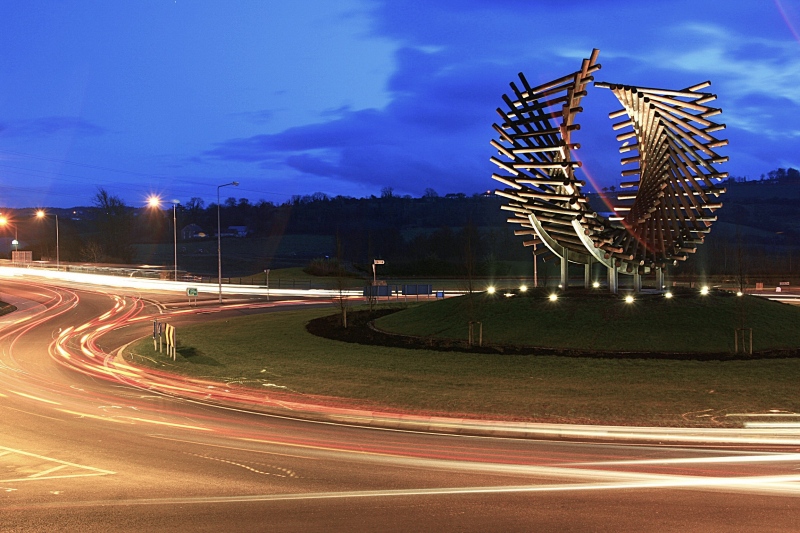
Polestar (2006) Timber (Telegraph) Poles, Galvanised steel. Letterkenny Co. Donegal, Ireland
'The artwork is made of 104 treated timber telegraph poles (each measuring approximately 300mm in diameter and 6.5 metres in length). The piece rises to a height of 12 metres, with a similar width, and a breadth of 6.5 metres, and is lit from below with 12 base-mounted spotlights. It was constructed using a series of triangular sections, bolted together with galvanised steel, and assembled in an interlocking pattern to produce an extruded, circular, star-like configuration.
The site of ‘Polestar’ (on the Port Bridge Roundabout, Letterkenny) was historically a hub for transport and trade, where goods arrived by boat, and were transported to the surrounding areas via rail and road and in particular here, the poles to carry out the “Electrification of Rural Ireland” programme during the mid 1940s onwards. The artist aimed to produce both a boat-like structure incorporating a locomotive/train-track theme, to commemorate the significance of these forms of transportation to the town's historical development'
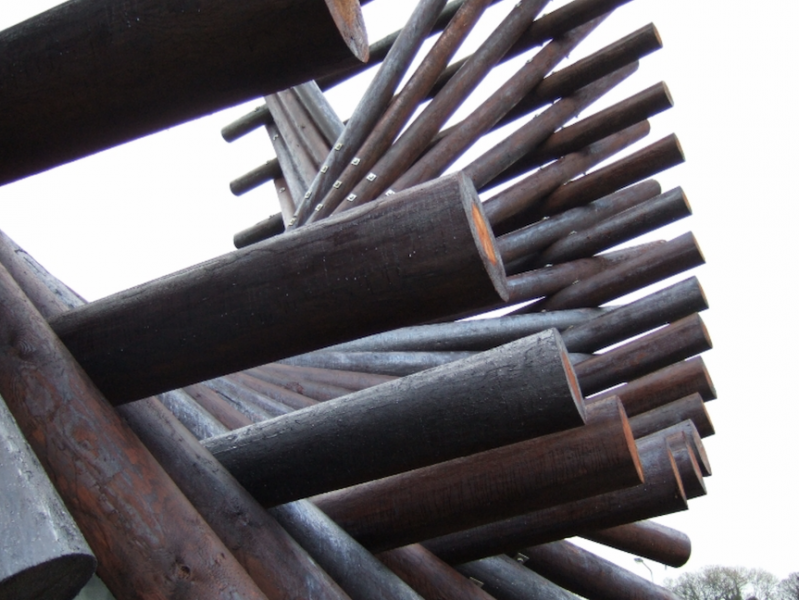
Polestar (2006) Timber (Telegraph) Poles, Galvanised steel. Letterkenny Co. Donegal, Ireland
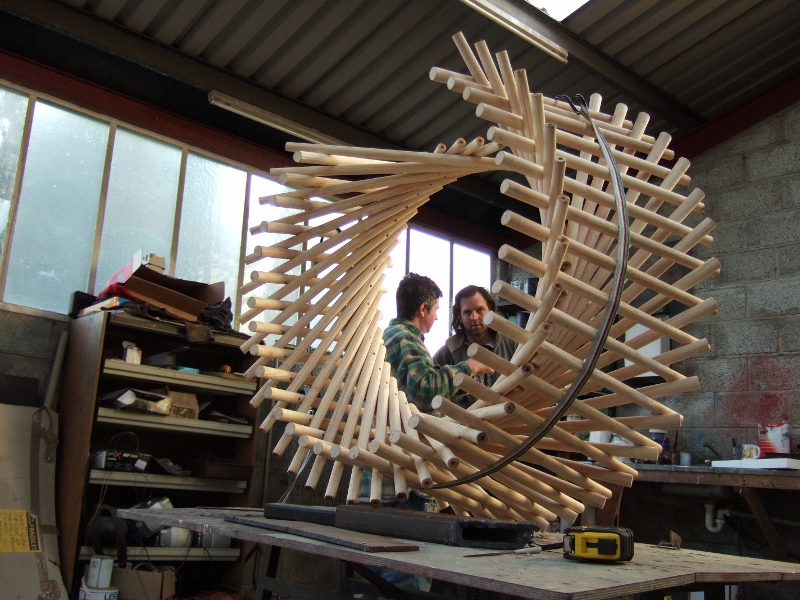
Polestar (2006) (Maquette) Timber (Telegraph) Poles, Galvanised steel. Letterkenny Co. Donegal, Ireland
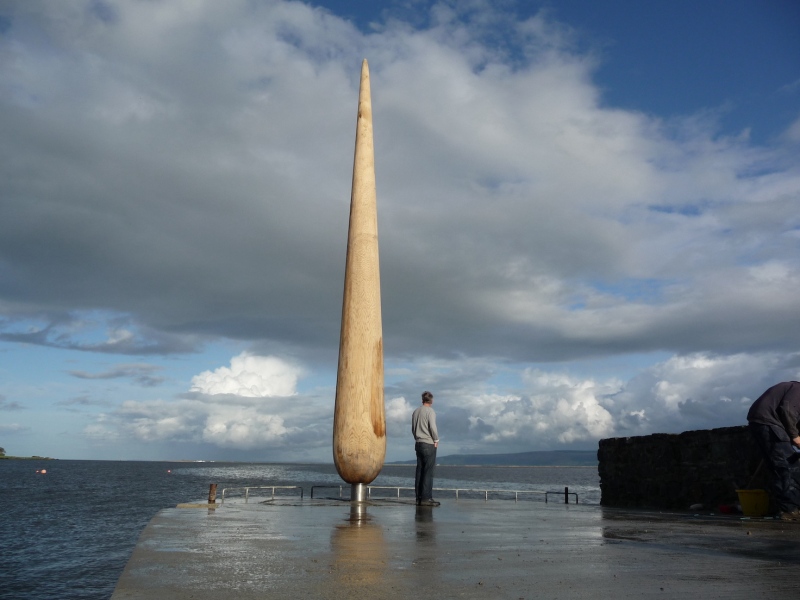
The Fid (2007) Oak, stainless steel. Old Stone Pier, Moville, Co. Donegal.
'This scene of Moville’s historic Old Stone Pier, linking the River Foyle with the land of Inishowen, now features the striking addition of a new sculpture by artist Locky Morris (carved from a single trunk of oak)
This commission from Donegal County Council Public Art Office follows on from the artist’s commission for Pole Star, his large sculpture which has become an iconic feature for Letterkenny.
The Fid at Moville Old Stone Pier has its inspirations within the village’s powerful connections to the sea and seafaring. The artist’s conversations with local people uncovered tales of the beacon fires, which were once lit on the hills of Inishowen to mark the passage down the River Foyle of emigration ships. And in Greencastle Maritime Museum the artist encountered an example of a ‘fid’, the small handheld tool turned from a piece of wood, used by fishermen for splicing ropes and nets and by sailmakers for opening holes in the sails without tearing the material. The final sculpture both recollects those beacon flames and that form of a ‘fid’. It unites this elegant and flowing form with an assured sense of scale and location – standing over 25 feet high and over three feet wide at base, sited at the end of the pier, facing directly onto a beautiful and dramatic seascape.
The Old Pier then, marks the village’s maritime heritage, for individual seafarers, emigrants and immigrants, their families, and the wider communities. In many ways, The Fid itself will act as a beacon towards this location: concentrating our vision and our thoughts upon those links between sea and land, which have made Moville'
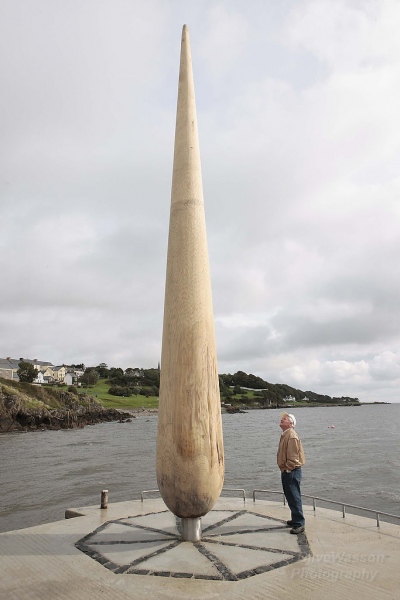
The Fid (2007) Oak, stainless steel. Old Stone Pier, Moville, Co. Donegal.
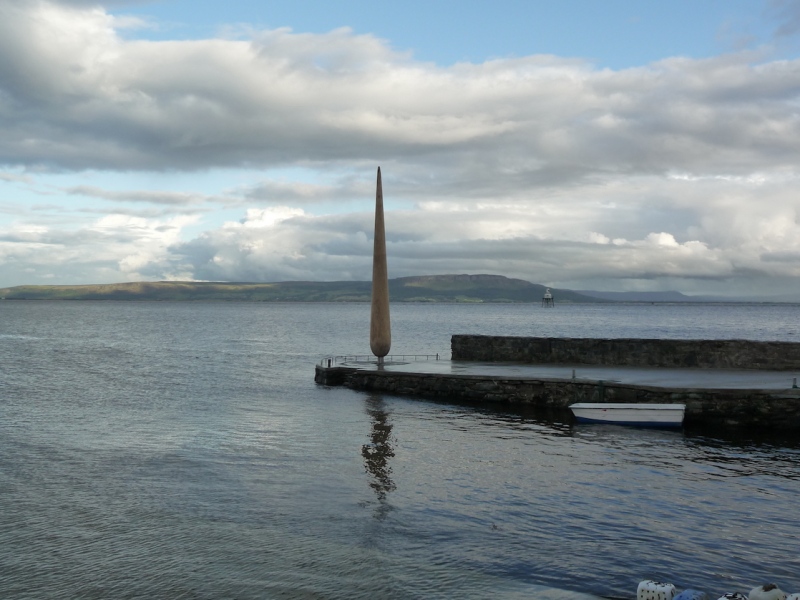
The Fid (2007) Oak, stainless steel. Old Stone Pier, Moville, Co. Donegal
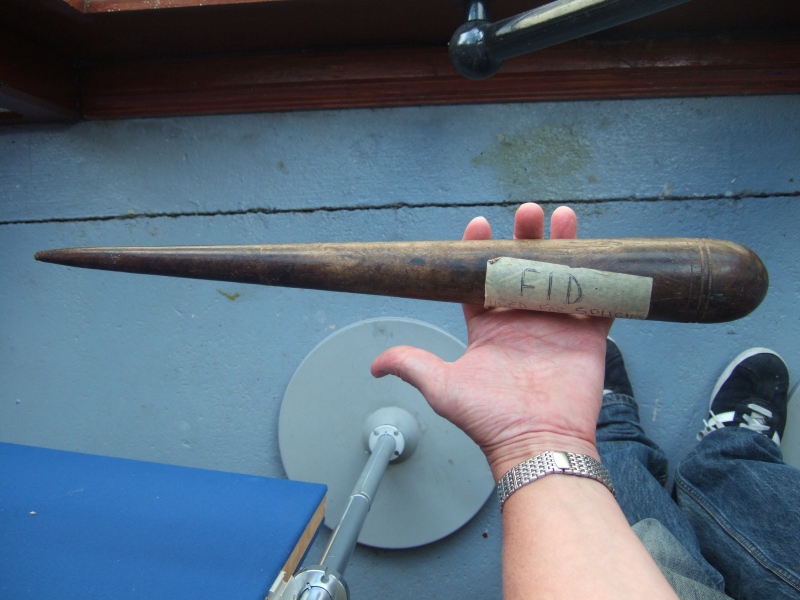
The Fid (2007) (research image)
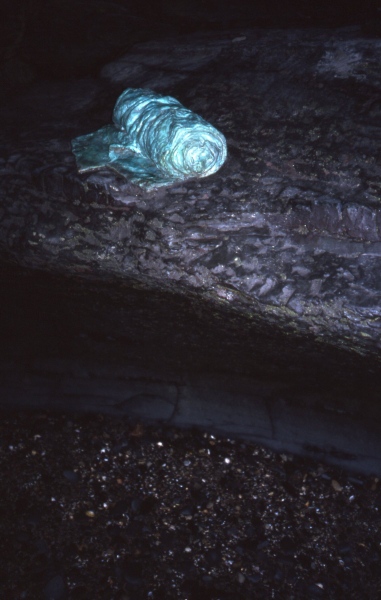
Dry (2000) Nine cast bronze towels. Bundoran Seafront Public Art Trail, Co. Donegal (cave image)

The first judgement of Ireland (2005) LED electronic panel, bronze cast lettering. Ballyshannon courthouse. Co. Donegal
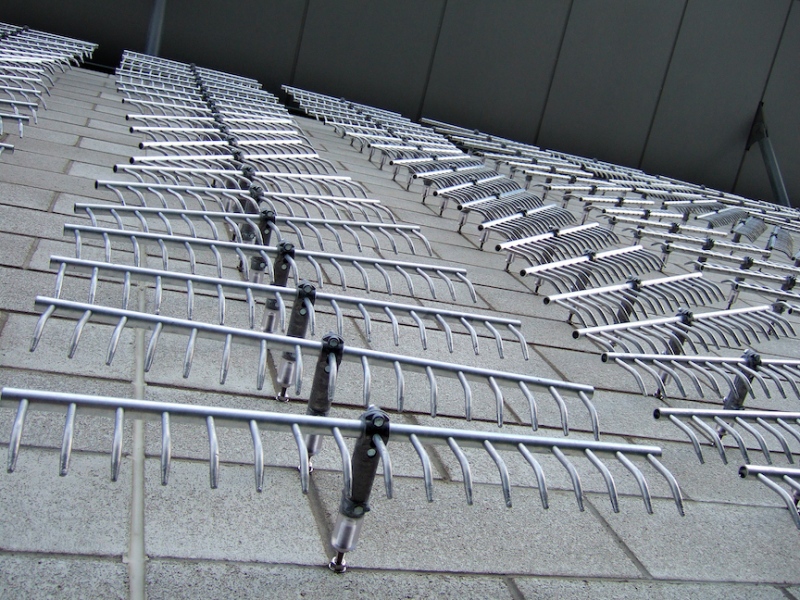
Movers and Shakers (2007) Aluminium rake heads, polycarbonate. LYIT. Co. Donegal
Made from 400 Aluminium rake heads, polycarbonate, stainless steel and located at the LYIT in Letterkenny Co. Donegal. Although Movers and Shakers is primarily abstract, its design is intended to suggest the movement of air or a sudden gust of wind over long grass or crops, in that sense, the arrangement is meant to be open to the chance play of light along the An Danlann Building. While it may point to a rural hinterland the intention was to maintain an almost digital aesthetic. The title makes playful reference to the contribution that will be made by the continual crops of students that pass through the college.
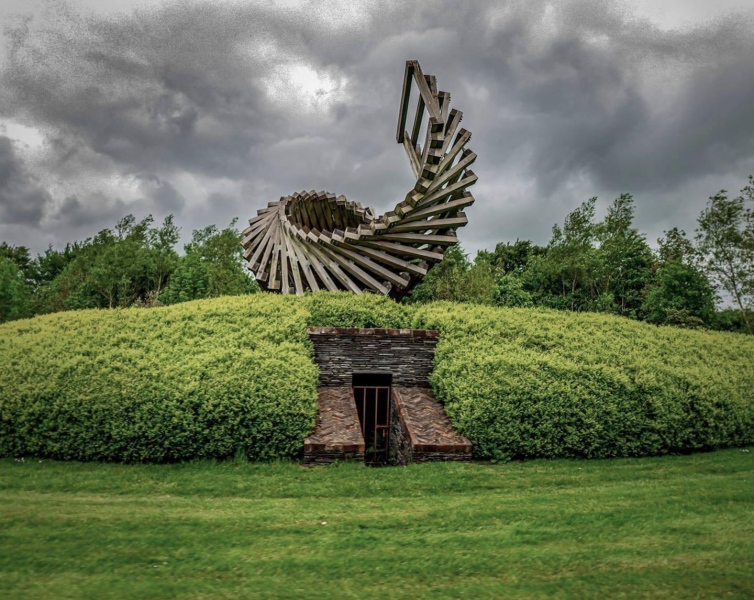
Longsleeper (2009) Oak, steel. Oakfield Park, Raphoe, Co. Donegal '...Longsleeper is made from 17 tons of Oak and appears to perform visual and structural acrobatics! This impressive sculpture has to be seen to be believed. Oakfield Park is renowned for is narrow gauge train and some of the inspiration for the piece comes from the railway.
The levers to alter the direction of the track at the ‘points’ were traditionally secured to a long sleeper. “This sense of movement and change is a central idea of the piece”, said Locky. Sited on the spiral mound it reveals itself to train passengers in a very dynamic way as they journey around the mound. No two views will be the same, as the straight oak sleepers appear to twist and turn, almost defying gravity. The spiral shape is reminiscent of the double helix of DNA, the genetic instructions for the building of all new life.
This birth, or rebirth theme, connects too, to the Biblical story of the awaking of the long sleepers at Ephesus. Locky said, “Oak is meant to make an obvious link with the name of the park but the dynamic revolving shape also echoes the spiral leaf arrangement on oak trees. I have visited the park in the past with my own young children and we were all knocked out with the place and especially its beautiful working railway and I tried to inject a sense of playfulness and lightness of touch to this very large and heavy structure”. Longsleeper can also be clearly seen in perfect alignment with the middle of Oakfield Park House, 750mtrs away, in keeping with the Georgian design ethos and the gardens. Its circular aspect frames the distant Croaghan Hill, with the ancient burial mound, where it appears to curl up and spin towards the sky'
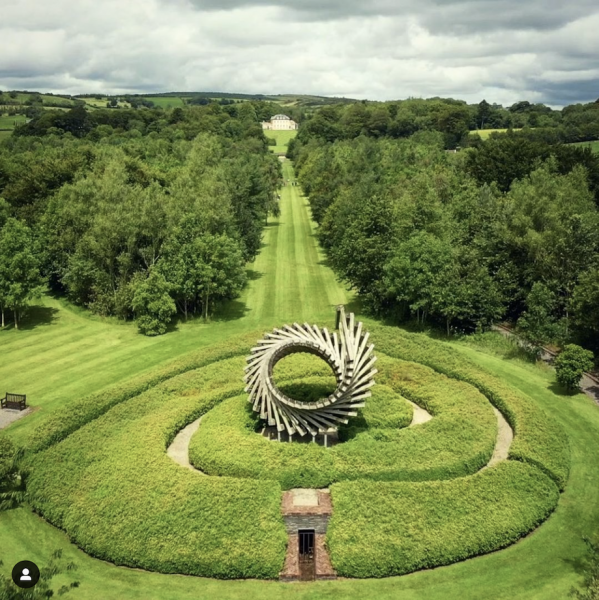
Longsleeper (2009) Oak, steel. Oakfield Park, Raphoe, Co. Donegal
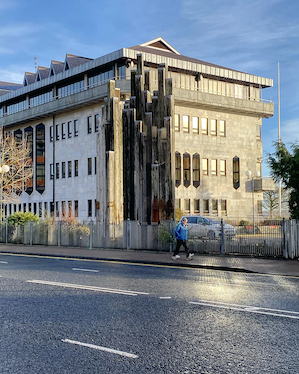
Atlantic Drift (1998) Reclaimed Timber (from the River Foyle) Steel, Lead. Derry City Council Offices
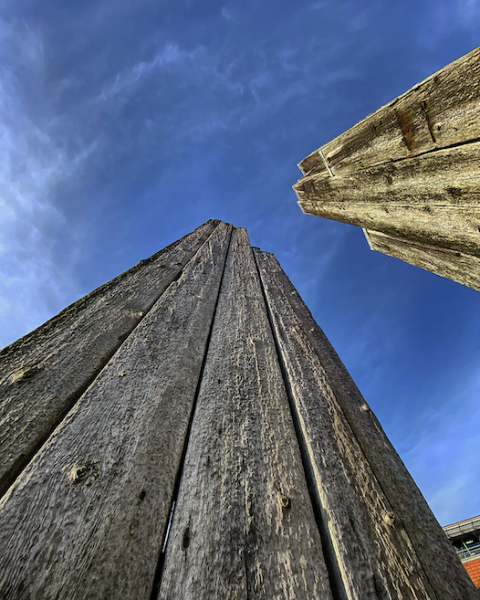
Atlantic Drift (detail) (1998) Salvaged Timber , steel, lead. Derry City Council Offices. '...This artwork was commissioned by Derry City Council after an open Public Art competition. The artist proposed as part of the project to salvage these huge timber piles from the old American jetty at Lisahally along the River Foyle. With Derry’s recent developments and rapidly changing landscape little remains of the old wooden docks and quays, rich material that gave clues into history. The timber piles now transformed into something new show the marks and effects of a lifetime in the river. These tidal markings could be seen as emblematic of Derry’s fascinating history as a port with it’s mainly waves of emigration and trade. The structure rises to 10.4 metres (34 feet) weighing 34 tons and forms a kind of totem, exploiting the sheer physical power and beauty of the wood. It refers directly to the processes of construction and strongly suggests skyscrapers and stepping stones. Like modernists architects’ experiments in the 1920s and 1930s with new urban forms - ‘iconic’ cathedrals to industry whose decorated surfaces cloak a more mechanical heart - the neat columns of Atlantic Drift belie a complex rhythm of space and form…’
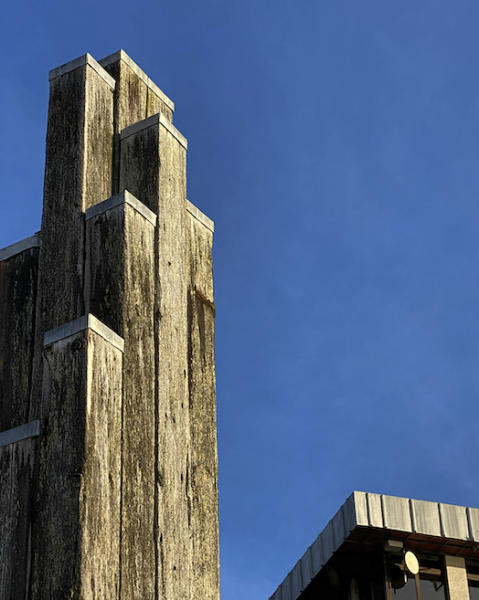
Atlantic Drift (detail) (1998) Reclaimed Timber (from the River Foyle) Steel, Lead. Derry City Council Offices
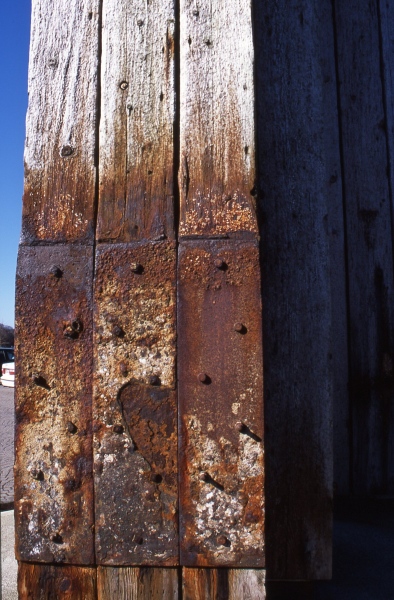
Atlantic Drift (detail) (1998) Reclaimed Timber (from the River Foyle) Steel, Lead. Derry City Council Offices
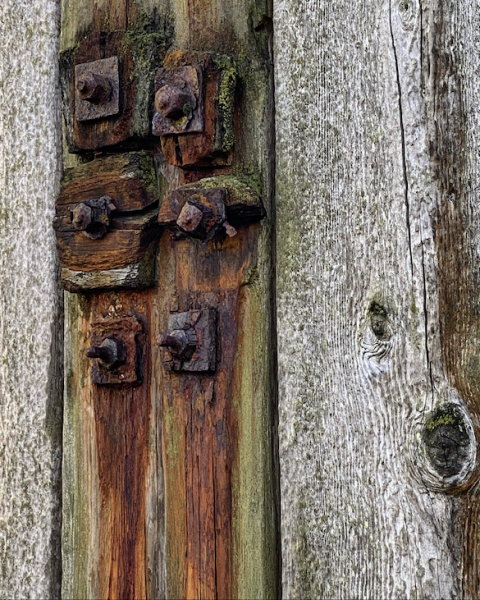
Atlantic Drift (detail) (1998) Reclaimed Timber (from the River Foyle) Steel, Lead. Derry City Council Offices

Atlantic Drift (plaque) (1998) Salvaged timber, steel, lead. Derry City Council Offices
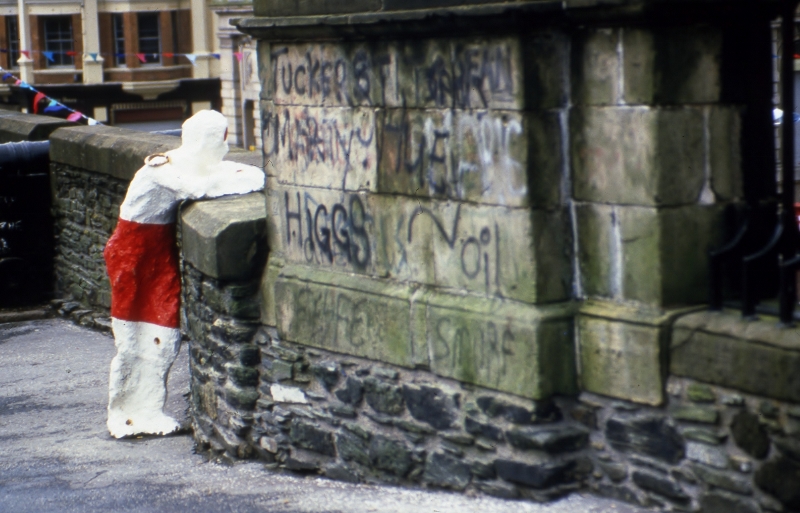
In Their Place (1986) City walls, Derry. Nine life size figures. Re-inforced concrete, paint, reflectors, metal rings. Guildhall square figure. ‘…This work was situated in an art practice which evolved through lived experience of the 1970’s Derry , art college in Belfast/Manchester in the late 1970s/80s and the artists’s commitment to return to Derry in the mid-80s, specifically for this proposal for a series of nine poured concrete sculptures, sited on the Derry Walls, of human figures cast from life - friends and acquaintances posed and anonymised by the artist. The artist defined In their Place as “political and politically metaphorical in the interests of producing new knowledge and renewed awareness of oppression” …The politics of the work was determined in its materials - the concrete of the bollards used in checkpoints in the militarised city - and in the responses it received in the locality, including the “active mutilating” of one beheaded sculpture, and the alleged army bombing of another’ (text extract, Four decades of Irish Sculpture, In their Place (1987) Locky Morris, Declan Sheehan, Visual Artists' News Sheet, Special Issue (2020)
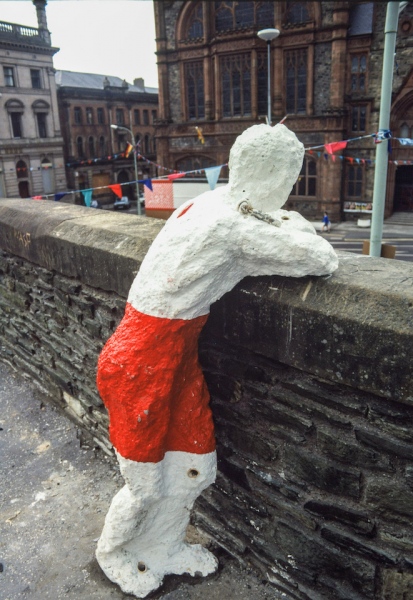
In Their Place (1986) City walls, Derry. Nine life size figures. Re-inforced concrete, paint, reflectors, metal rings. Guildhall square figure

In Their Place (1986) City walls, Derry. Nine life size figures. Re-inforced concrete, paint, reflectors, metal rings. Resting shopping figure. East wall

In Their Place (1986) City walls, Derry. Nine life size figures. Re-inforced concrete, paint, reflectors, metal rings. Resting shopping figure. East wall
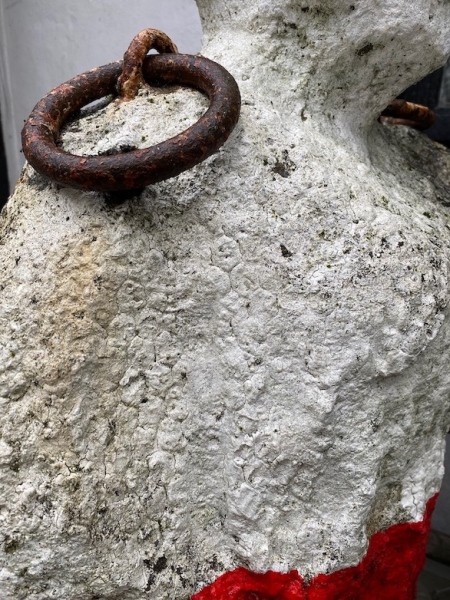
In Their Place (1986) (detail) City walls, Derry. Nine life size figures. Re-inforced concrete, paint, reflectors, metal rings. Resting shopping figure. East wall
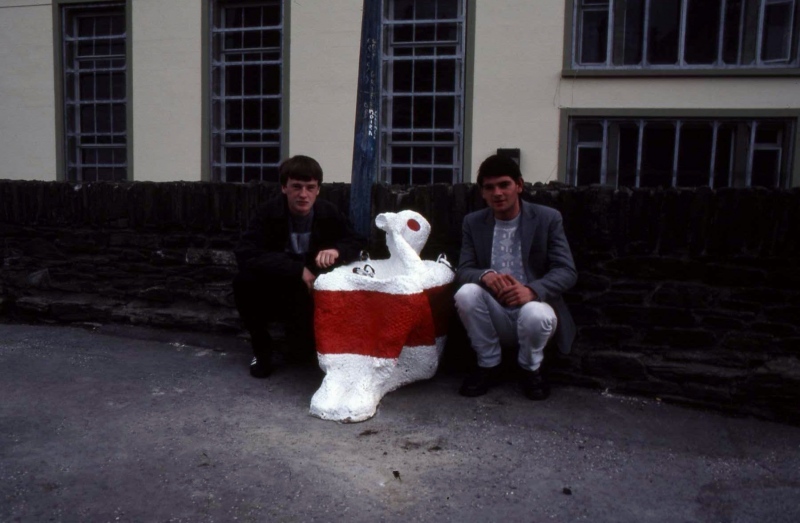
In Their Place (1986) City walls, Derry. Nine life size figures. Re-inforced concrete, paint, reflectors, metal rings. Drinking figure. Guildhall Square
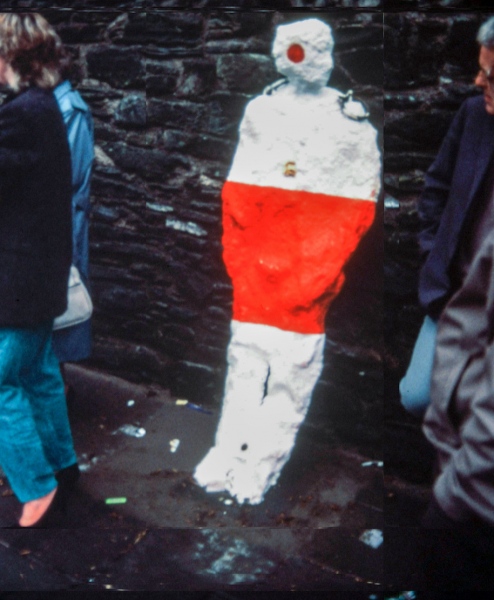
In Their Place (1986) City walls, Derry. Nine life size figures. Re-inforced concrete, paint, reflectors, metal rings. Guildhall Square bustop figure
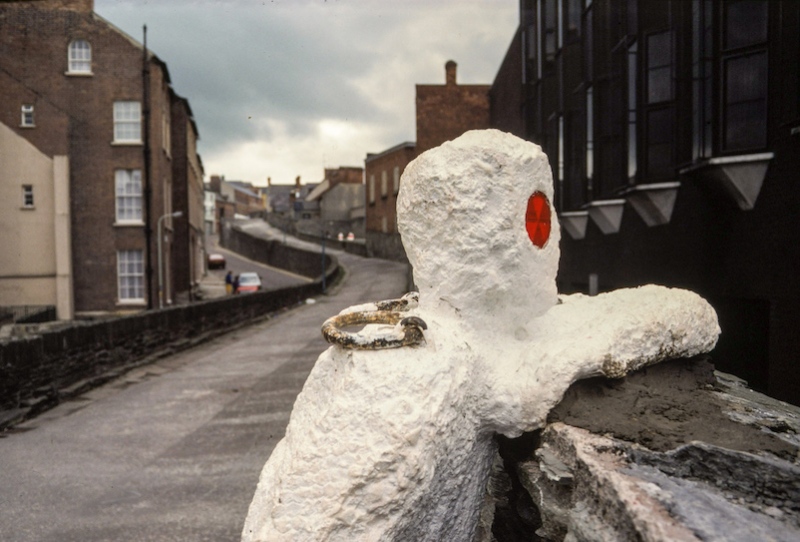
In Their Place (1986) City walls, Derry. Nine life size figures. Re-inforced concrete, paint, reflectors, metal rings. Magazine gate figure
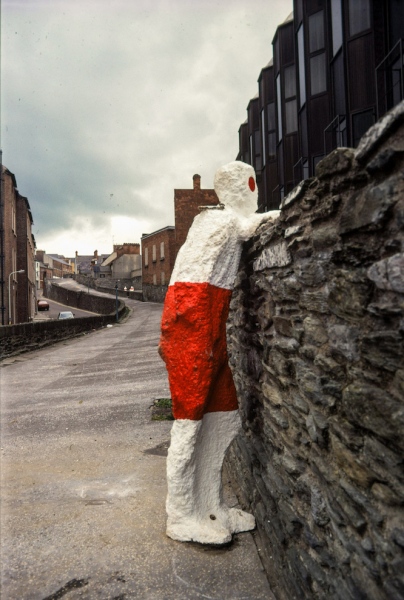
In Their Place (1986) City walls, Derry. Nine life size figures. Re-inforced concrete, paint, reflectors, metal rings. Magazine gate figure/Hangmans bastion reading figures

In Their Place (1986) City walls, Derry. Security bollard, Bishop Street Within (research image)
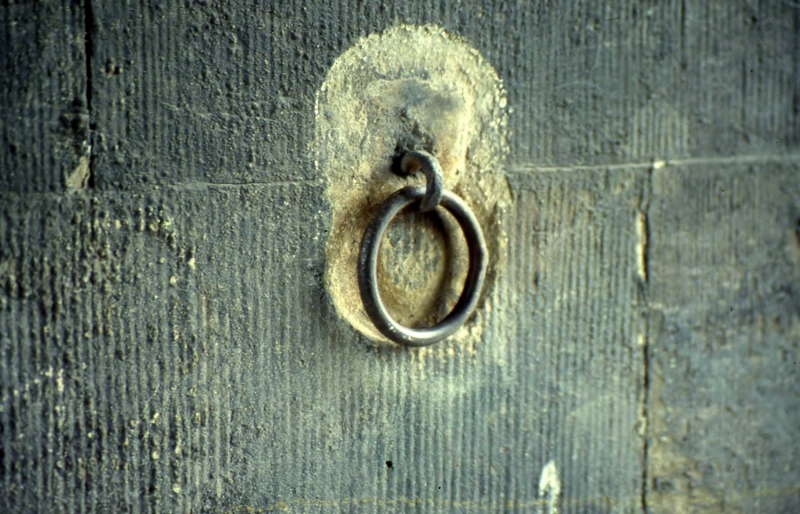
In Their Place (1986) City walls, Derry. Metal rings Ferryquay Gate (research image)
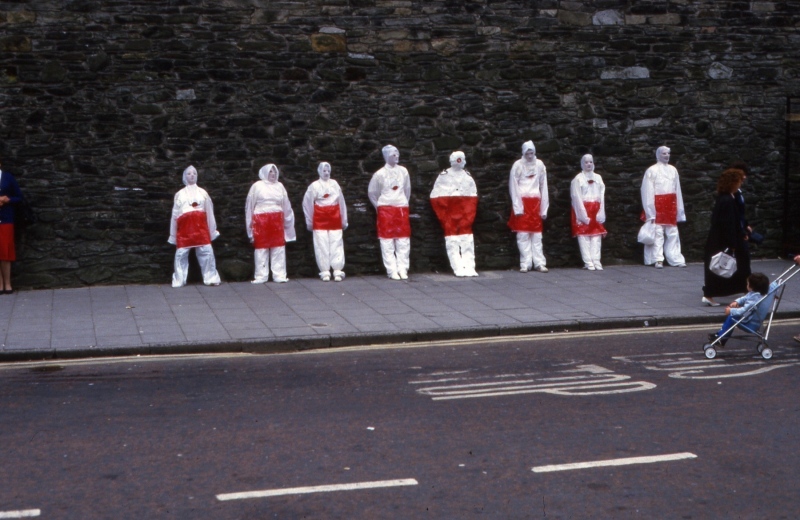
In Their Place (1986) City walls, Derry. Nine life size figures. Re-inforced concrete, paint, reflectors, metal rings. Guildhall Square bustop figure (street theatre performance)

In Their Place (1986) City walls, Derry. Nine life size figures. Re-inforced concrete, paint, reflectors, metal rings. Guildhall Square bustop figure (street theatre performance)
-
1
We Shall Overcome (2017) Weathering Steel. Integrated architectural artwork. Museum of Free Derry. Glenfada Park, Derry
'The artwork on the front of this museum shows the sound waveform of the moments on the day of Bloody Sunday in Derry in 1972, when the crowd sings 'We Shall Overcome’, a song that had become an anthem for the Civil Rights movement from the late 1950s and early 60s onwards.
An emphasis is placed on the surface of the museum having been cut into, along with the suggestion of a huge moment of seismographic shift. It draws also on a number of other ideas, among which are the lines of the wooden fence that would have run along this part of Glenfada Park and in a certain sense draws another line with the infamous ‘rubble barricade’ that would have crossed Rossville Street on that fateful day. Although it has its focus around this momentous event, it is hoped that it will resonate outside this context and connect, historically and contemporaneously, with a wider international communal struggle and desire for Justice and Civil Rights'
-
2
We Shall Overcome (2017) (detail) Weathering Steel. Integrated architectural artwork. Museum of Free Derry, Glenfada Park, Derry
-
3
We Shall Overcome (2017) (detail) Weathering Steel. Integrated architectural artwork. Museum of Free Derry, Glenfada Park, Derry
-
4
Dead On (2013/14) Dead Elm tree, audio, hardware. Brooke Park, Derry. Void Gallery Sites Gardens' Project
-
5
'The tree, an elm, was killed by Dutch Elm Disease, caused by the fungus Ophiostoma novo-ulmi. It is a type of disease known as a vascular wilt because the fungus blocks the vascular (water transport) system, causing the branches to wilt and die. It is spread by elm bark beetles Scolytus multistriatus. The beetles burrow their way into the dying or dead tree, the female laying eggs and adults, carrying the Dutch Elm pathogen emerge into the world to find new victims nearby.
Drilling and boring has been at the essence of Morris’s approach to Dead On mimicking the bark beetle’s invasion on the conscious and subconscious level. Many of us have a terror of drilling, often caused by the fear of the dentist’s drill, so much so that we’d rather endure the pain of toothache than go to the dentist. There’s even a term for it: Odontophobia - a state of denial, a terror of invasion even that of a supposedly benign nature. So if we’re afraid of what’s good for us imagine how terrifying the indifference of nature is; how the insectoid, the fungal, the viral care nothing for our civilization or superiority. As we listen to the tree, something is alive in there. The sounds are familiar yet unsettling; something seems to be eating its way out…
Locky Morris was born in Derry, where he continues to live and work. He has been exhibiting nationally and internationally since the mid - 1980s while also exhibiting in a wide range of spaces in his local neighbourhood. His practice has also included many works and interventions in he public realm.
Dead On is the third of the Void 'gardens' and it continues the theme of considering public art in a new light; as something fluid and subtle yet epic, rather than static, concrete and monumental' (text Gregory Mc Cartney)
-
6
Dead On (2013/14) Dead Elm tree, audio, hardware. Brooke Park, Derry. Void Gallery Sites Gardens' Project (poster)
-
7
Dead On (2013/14) 12" grey vinyl remix element. Featuring T.A.F.D. (Shamman Delly) Vincent, Planting. Void Gallery Sites Gardens' Project.
-
8
Dead On (2013/14) (extract) 12" grey vinyl remix element. Featuring T.A.F.D. (Shamman Delly) Vincent, Planting. Void Gallery Sites Gardens' Project.
-
9
Polestar (2006) Timber (Telegraph) Poles, Galvanised steel. Letterkenny Co. Donegal, Ireland
'The artwork is made of 104 treated timber telegraph poles (each measuring approximately 300mm in diameter and 6.5 metres in length). The piece rises to a height of 12 metres, with a similar width, and a breadth of 6.5 metres, and is lit from below with 12 base-mounted spotlights. It was constructed using a series of triangular sections, bolted together with galvanised steel, and assembled in an interlocking pattern to produce an extruded, circular, star-like configuration.
The site of ‘Polestar’ (on the Port Bridge Roundabout, Letterkenny) was historically a hub for transport and trade, where goods arrived by boat, and were transported to the surrounding areas via rail and road and in particular here, the poles to carry out the “Electrification of Rural Ireland” programme during the mid 1940s onwards. The artist aimed to produce both a boat-like structure incorporating a locomotive/train-track theme, to commemorate the significance of these forms of transportation to the town's historical development'
-
10
Polestar (2006) Timber (Telegraph) Poles, Galvanised steel. Letterkenny Co. Donegal, Ireland
-
11
Polestar (2006) (Maquette) Timber (Telegraph) Poles, Galvanised steel. Letterkenny Co. Donegal, Ireland
-
12
The Fid (2007) Oak, stainless steel. Old Stone Pier, Moville, Co. Donegal.
'This scene of Moville’s historic Old Stone Pier, linking the River Foyle with the land of Inishowen, now features the striking addition of a new sculpture by artist Locky Morris (carved from a single trunk of oak)
This commission from Donegal County Council Public Art Office follows on from the artist’s commission for Pole Star, his large sculpture which has become an iconic feature for Letterkenny.
The Fid at Moville Old Stone Pier has its inspirations within the village’s powerful connections to the sea and seafaring. The artist’s conversations with local people uncovered tales of the beacon fires, which were once lit on the hills of Inishowen to mark the passage down the River Foyle of emigration ships. And in Greencastle Maritime Museum the artist encountered an example of a ‘fid’, the small handheld tool turned from a piece of wood, used by fishermen for splicing ropes and nets and by sailmakers for opening holes in the sails without tearing the material. The final sculpture both recollects those beacon flames and that form of a ‘fid’. It unites this elegant and flowing form with an assured sense of scale and location – standing over 25 feet high and over three feet wide at base, sited at the end of the pier, facing directly onto a beautiful and dramatic seascape.
The Old Pier then, marks the village’s maritime heritage, for individual seafarers, emigrants and immigrants, their families, and the wider communities. In many ways, The Fid itself will act as a beacon towards this location: concentrating our vision and our thoughts upon those links between sea and land, which have made Moville'
-
13
The Fid (2007) Oak, stainless steel. Old Stone Pier, Moville, Co. Donegal.
-
14
The Fid (2007) Oak, stainless steel. Old Stone Pier, Moville, Co. Donegal
-
15
The Fid (2007) (research image)
-
16
Dry (2000) Nine cast bronze towels. Bundoran Seafront Public Art Trail, Co. Donegal (cave image)
-
17
The first judgement of Ireland (2005) LED electronic panel, bronze cast lettering. Ballyshannon courthouse. Co. Donegal
-
18
Movers and Shakers (2007) Aluminium rake heads, polycarbonate. LYIT. Co. Donegal
Made from 400 Aluminium rake heads, polycarbonate, stainless steel and located at the LYIT in Letterkenny Co. Donegal. Although Movers and Shakers is primarily abstract, its design is intended to suggest the movement of air or a sudden gust of wind over long grass or crops, in that sense, the arrangement is meant to be open to the chance play of light along the An Danlann Building. While it may point to a rural hinterland the intention was to maintain an almost digital aesthetic. The title makes playful reference to the contribution that will be made by the continual crops of students that pass through the college.
-
19
Longsleeper (2009) Oak, steel. Oakfield Park, Raphoe, Co. Donegal '...Longsleeper is made from 17 tons of Oak and appears to perform visual and structural acrobatics! This impressive sculpture has to be seen to be believed. Oakfield Park is renowned for is narrow gauge train and some of the inspiration for the piece comes from the railway.
The levers to alter the direction of the track at the ‘points’ were traditionally secured to a long sleeper. “This sense of movement and change is a central idea of the piece”, said Locky. Sited on the spiral mound it reveals itself to train passengers in a very dynamic way as they journey around the mound. No two views will be the same, as the straight oak sleepers appear to twist and turn, almost defying gravity. The spiral shape is reminiscent of the double helix of DNA, the genetic instructions for the building of all new life.
This birth, or rebirth theme, connects too, to the Biblical story of the awaking of the long sleepers at Ephesus. Locky said, “Oak is meant to make an obvious link with the name of the park but the dynamic revolving shape also echoes the spiral leaf arrangement on oak trees. I have visited the park in the past with my own young children and we were all knocked out with the place and especially its beautiful working railway and I tried to inject a sense of playfulness and lightness of touch to this very large and heavy structure”. Longsleeper can also be clearly seen in perfect alignment with the middle of Oakfield Park House, 750mtrs away, in keeping with the Georgian design ethos and the gardens. Its circular aspect frames the distant Croaghan Hill, with the ancient burial mound, where it appears to curl up and spin towards the sky'
-
20
Longsleeper (2009) Oak, steel. Oakfield Park, Raphoe, Co. Donegal
-
21
Atlantic Drift (1998) Reclaimed Timber (from the River Foyle) Steel, Lead. Derry City Council Offices
-
22
Atlantic Drift (detail) (1998) Salvaged Timber , steel, lead. Derry City Council Offices. '...This artwork was commissioned by Derry City Council after an open Public Art competition. The artist proposed as part of the project to salvage these huge timber piles from the old American jetty at Lisahally along the River Foyle. With Derry’s recent developments and rapidly changing landscape little remains of the old wooden docks and quays, rich material that gave clues into history. The timber piles now transformed into something new show the marks and effects of a lifetime in the river. These tidal markings could be seen as emblematic of Derry’s fascinating history as a port with it’s mainly waves of emigration and trade. The structure rises to 10.4 metres (34 feet) weighing 34 tons and forms a kind of totem, exploiting the sheer physical power and beauty of the wood. It refers directly to the processes of construction and strongly suggests skyscrapers and stepping stones. Like modernists architects’ experiments in the 1920s and 1930s with new urban forms - ‘iconic’ cathedrals to industry whose decorated surfaces cloak a more mechanical heart - the neat columns of Atlantic Drift belie a complex rhythm of space and form…’
-
23
Atlantic Drift (detail) (1998) Reclaimed Timber (from the River Foyle) Steel, Lead. Derry City Council Offices
-
24
Atlantic Drift (detail) (1998) Reclaimed Timber (from the River Foyle) Steel, Lead. Derry City Council Offices
-
25
Atlantic Drift (detail) (1998) Reclaimed Timber (from the River Foyle) Steel, Lead. Derry City Council Offices
-
26
Atlantic Drift (plaque) (1998) Salvaged timber, steel, lead. Derry City Council Offices
-
27
In Their Place (1986) City walls, Derry. Nine life size figures. Re-inforced concrete, paint, reflectors, metal rings. Guildhall square figure. ‘…This work was situated in an art practice which evolved through lived experience of the 1970’s Derry , art college in Belfast/Manchester in the late 1970s/80s and the artists’s commitment to return to Derry in the mid-80s, specifically for this proposal for a series of nine poured concrete sculptures, sited on the Derry Walls, of human figures cast from life - friends and acquaintances posed and anonymised by the artist. The artist defined In their Place as “political and politically metaphorical in the interests of producing new knowledge and renewed awareness of oppression” …The politics of the work was determined in its materials - the concrete of the bollards used in checkpoints in the militarised city - and in the responses it received in the locality, including the “active mutilating” of one beheaded sculpture, and the alleged army bombing of another’ (text extract, Four decades of Irish Sculpture, In their Place (1987) Locky Morris, Declan Sheehan, Visual Artists' News Sheet, Special Issue (2020)
-
28
In Their Place (1986) City walls, Derry. Nine life size figures. Re-inforced concrete, paint, reflectors, metal rings. Guildhall square figure
-
29
In Their Place (1986) City walls, Derry. Nine life size figures. Re-inforced concrete, paint, reflectors, metal rings. Resting shopping figure. East wall
-
30
In Their Place (1986) City walls, Derry. Nine life size figures. Re-inforced concrete, paint, reflectors, metal rings. Resting shopping figure. East wall
-
31
In Their Place (1986) (detail) City walls, Derry. Nine life size figures. Re-inforced concrete, paint, reflectors, metal rings. Resting shopping figure. East wall
-
32
In Their Place (1986) City walls, Derry. Nine life size figures. Re-inforced concrete, paint, reflectors, metal rings. Drinking figure. Guildhall Square
-
33
In Their Place (1986) City walls, Derry. Nine life size figures. Re-inforced concrete, paint, reflectors, metal rings. Guildhall Square bustop figure
-
34
In Their Place (1986) City walls, Derry. Nine life size figures. Re-inforced concrete, paint, reflectors, metal rings. Magazine gate figure
-
35
In Their Place (1986) City walls, Derry. Nine life size figures. Re-inforced concrete, paint, reflectors, metal rings. Magazine gate figure/Hangmans bastion reading figures
-
36
In Their Place (1986) City walls, Derry. Security bollard, Bishop Street Within (research image)
-
37
In Their Place (1986) City walls, Derry. Metal rings Ferryquay Gate (research image)
-
38
In Their Place (1986) City walls, Derry. Nine life size figures. Re-inforced concrete, paint, reflectors, metal rings. Guildhall Square bustop figure (street theatre performance)
-
39
In Their Place (1986) City walls, Derry. Nine life size figures. Re-inforced concrete, paint, reflectors, metal rings. Guildhall Square bustop figure (street theatre performance)
Selected major commissions from 1987 · click on images for more info / scroll right and left